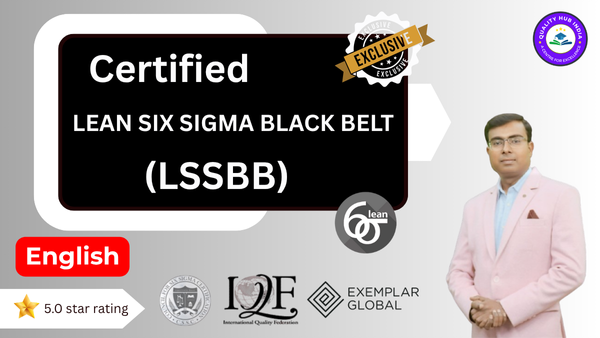There are no items in your cart
Add More
Add More
| Item Details | Price | ||
|---|---|---|---|
CSSC, IQF & IAO accredited globally recognized certification course on Lean Six Sigma Black Belt (LSSBB)
5.0 (1105 ratings)
Language: English
Instructors: Dr. Aryan Viswakarma
Validity Period: 1095 days
Why this course?
Course: Lean Six Sigma Black Belt
Course Duration: 51 hrs
Description
Quality HUB India™ brings you the Lean Six Sigma Black Belt E-Learning training course that will help you aim for a first-time pass of the Six Sigma Black Belt exam and gain the expertise to be a success at the workplace.
As a Lean Six Sigma Black Belt paraprofessional, you will be responsible for leading or facilitating improvement initiatives within the organization. You will do this by applying a data-driven approach to eliminate defects and improve processes in the organization. The Six Sigma Black Belt certification helps create a mindset and culture shift that eliminates waste of time and resources and replaces the methods used in traditional contexts with a set of tools that produce near-perfect results. Our comprehensive training will help you gain a thorough understanding of the methods that will help analyze and solve quality problems and create a high-performance organization with a focus on continual improvement. Enroll today and gain the certificate that will reflect your understanding of Lean Six Sigma and its focus on eliminating defects and waste through process improvement and variation reduction.
Course Objectives
To provide students with the adequate knowledge required to understand and practice Lean Six Sigma Methodology used in industry.
Details for accessing your course will be emailed to you upon confirmation of your registration (may take up to 12 hours from submission).
Prerequisites
It is recommended that all students have the following prior knowledge:
Who Should Attend?
This course is ideal for those who are responsible for product development, operations management, quality control, and engineering including department managers, supervisors, quality representatives, engineers, and administrative staff who have a focus on business improvement, performance, and profitability.
Join Our Weekly Live Doubt-Clearing Sessions
We are committed to your learning success! To ensure clarity and help you achieve your goals, we conduct live doubt-clearing sessions every week.
Why Attend?
Certification Exam Guidelines
Examination Format:
Course Validity & Exam Timeline:
Note: Attempting the exam after the one-year period will require an additional fee.
Certification:
Sample Certificate:
Policy on Cancellation and Refunds
For Technical Support-
Contact us at +91-7988283436 or drop a mail at care@qualityhubindia.com
*Prices may change at any time without prior notice.
REQUEST FOR COURSE VALIDITY EXTENSION
You can also pay by scanning a QR code. Kindly share a screenshot by mail at care@qualityhubindia.com with full details after payment (Name, Email id, Contact No. and Course Name)

Benefits of Doing Courses from Quality HUB India™
Awards & Recognitions
Accreditations & Certifications

· What is Six Sigma?
· Why Six Sigma is not good enough?
· Variance Based Thinking and ISO VS TQM VS Six Sigma
· Cost of Quality and Six Sigma relationship, Benefits of Six Sigma
· DMAIC Stages overview
· DMAIC Stages VS tools, DMAIC VS DMADV
· Understanding DPU, PPM, DPMO with case study
· Difference between Lean Vs Six Sigma Methodology
· TAKT Time VS Cycle Time VS Lead Time VS Throughput Time – Difference explained with example
LSSBB Define Phase
· Establish Critical to Quality (CTQ) Characteristics
· Explore Customer CTQ and Examples of Customer Responses on CTQs
· Kano Diagram and Implied Needs, Stated Needs, Unstated Needs and Shifting Needs
· Define Internal CTQ and CBP
· Quality Function Deployment (QFD) and Typical 4 House QFD
· QFD Flow in Various Environments, Benefits and Examples of QFD
· Define a Project and Project Approach to Six Sigma
· Types of Project Selection and Steps in Project Selection
· Brainstorming and Multivoting
· Theme selection Matrix and Define Ways to Select a Project
· Project Selection Summary
· Scope the Project
· SIPOC method
· Developing Team Charter. Reason for Teaming and Team Composition
· Quantify Benefits and Project Sign off
· Defining Problem Statement and Kick off the Project
· Create Matrix with Team and Define Tollgate
· First Pass Yield (FPY) VS Rolled Throughput Yield
· 5W and 1H Technique -Define Problem Perfectly
· SMART Goal Setting
· Cost of Quality (COQ), Its Categories and benefits
· Understanding Project Charter with Case Studies
LSSBB Measure Phase
· Introduction to Measure
· Establish Performance Parameters Process and SIPOC Diagram
· Process Mapping Nomenclature and Benefits of Process Mapping
· Define a Unit and Define Specifications Defect
· What is Specification and What is a Characteristic?
· Develop Operational Definition with Examples
· Understand Data Characteristics and Why collect data?
· Types of data and data characteristics
· Which type of data is Preferable and Design Sampling Plan for Establishing Process Baseline
· Introduction to Sampling and Types of Sampling
· Validate Measurement System for 'Y' and Types of Measurement Errors
· Sources of Variation and Accuracy and Precision
Measurement System Analysis (MSA)
· Introduction to Measurement System Analysis (MSA)
· Understand Measurement as a Process
· Sources of Variation
· Fundamental Properties of Measurement System
· Accuracy and Precision
· Location and Spread error
· Bias, Linearity and Stability
· Possible Causes for Bias, Linearity
· Repeatability and Reproducibility
· Measurement Capability Index
· How to Conduct Variable Gauge R and R
· Acceptance Criteria (variable Gauge MSA)
· Variable Gauge R and R Study in Excel (Case Study)
· Attribute Agreement Analysis and Acceptance Criteria
· Attribute Agreement Analysis (Minitab Case Study)
· Variable Crossed Gauge RR (Minitab Case Study)
LSSBB Analyze Phase
· Establish Process Baseline and Defects per Million Opportunities (DPMO)
· Categorizing Defects - Pareto Diagram and Z Calculation Worksheet - Discrete Data
· Introduction to Normal Distribution and Standard Normal Distribution
· Concept of Z Value
· Process Sigma Multiple for Continuous Data and Concept of Process shift
· Variation Names of Process Variations and Calculating Process variations
· Process Capability Study and Capability Index
· Analyzing Continuous Data- Histograms
· Analyzing Continuous Data- Run Charts
· Stratification and Using Minitab for Stratifying Data
· Analyzing Patterns in Process Distribution and Transformation
· Sampling Distribution and Graphical Representation
· Introduction to t-distribution and Use of t-distribution Table
· Estimate Population Parameter from Sample Statistic and Interval Estimates using t-distribution
· Define Performance Goals and Entitlement on Cycle Time
· Process of Benchmarking
· Introduction to Hypothesis Test, Null and Alternate Hypothesis
· Type 1 and Type II Error
· Test Criteria of the Hypothesis- Two Tailed & One Tailed Test of Hypothesis
· Improvement Goal on Discrete Data and Binomial Distribution
· Introduction to Poisson Distribution
· Chi Square Test and Preparing Contingency Table
· Improvement Goal on Continuous Data and One Sample Two-sided t-Test
· ANOVA-One Way and Two Way
· F-Test -Hypothesis Test with Minitab
· Identify Variation Sources
· Fishbone- Mile Deep & Not Wide and Fishbone Structure
· Prioritization Tool
· Prioritization Tool- Pareto Chart
· What is Correlation Analysis?
· What is Regression & Simple Linear Regression? How to do in Minitab
· Multiple Linear Regression (MLR) and Polynomial Regression
· Analysis of Variance (ANOVA)
· Analysis of Means (ANOM)
· General Linear Model of ANOVA
· Chi-Square Test with Minitab
· Failure Mode and Effects Analysis
· Theory of Constraints (TOC)
Basic Problem-Solving Tools
· Fishbone Diagram or Cause-Effect Diagram
· Fishbone Diagram 'Case Study
· Pareto Chart or Pareto Diagram- A Prioritization Tool
· Pareto Chart (Case Study)
· Flow Chart Method
· Histogram -Data Distribution Tool
· Check Sheet (with case study)
· Scatter Plot or Scatter Diagram
· Control Chart and its types
Cause and Effect Matrix- Prioritization Tool
· Cause and Effect Matrix
· Cause and Effect (Case Study)
Support Problem-Solving Tools and modules
· Box and Whisker Plot
· RACI Matrix Chart- Introduction, Key Responsibility Roles (RACI Model), PARIS, PACSI, RASCI, DACI, and CAIRO
· What is Threat and Opportunity Matrix? Why Opportunity and Threat Matrix and Case Study
· Critical to Quality Tree (CTQ Tree), Case Study- Meal Performance and Customer Requirement
· SIPOC Diagram - Introduction, how can SIPOC be used? How SIPOC works and SIPOC Diagram Type 2
· Types of Six Sigma Certifications and their Roles - Different Levels of sigma and Roles
· How to Select Prepare Graph for analysis in Minitab
· Sampling and types of sampling
· Overview for Multi-Vari Chart(Minitab), Multivari Analysis and Case Study of Multi Vari Chart
Analysis of Variance (ANOVA)
· Intro to ANOVA (Analysis of Variance)
· ANOVA-Additivity and Total Variance- Data Dimension and Total Variance Calculation
· ANOVA (One Way ANOVA Step 1 and 2)- Components of Variation and Calculation of the sum of squares
· ANOVA (Degree of Freedom)
· ANOVA- Calculation of Mean Square, Calculation of the F- Ratio and Testing for significance
· ANOVA in Minitab- 95% Confidence Intervals
· ANOVA Summary and Crossed VS Nested Design
· ANOVA (Minitab Case Study)- Molding Process
Analysis of Means (ANOM)
· Introduction to ANOM
· Difference between ANOVA and ANOM
· Minitab Case Study
Regression Analysis
· Intro to Regression and Scatter Plot
· Correlation Analysis
· Introduction to Linear Regression
· Scatter Diagram, Regression (Minitab Example)
· ANOVA for Linear Regression and Normality of Residuals
· Regression- Interpolation and Extrapolation summary
· Scatter, Correlation and Regression (Minitab Exercises)
Non-Parametric Test
· Introduction to Non- Parametric Test. Difference between Parametric and Non-Parametric Test
· Sample Sign Test
· Man Whitney Test
· Moods Median Test
· Kruskal Wallis Test
LSSBB Improve Phase
· Explore Potential Causes and Deign of Experiments (DOE)
· DOE Nomenclature
· Types of Experiment Designs and Factorial Designs
· DOE setting in Designs- Two level & Three Factor Design
· Establish Variable Relationships and Determine the Operating Limits
· Counter-Measure Matrix
· Map the new Process and Sources of Resistance
· Introduction, Benefits, and How DOE works?
· How DOE works –Example
· DOE Key Terms
· Steps, One Factor at a Time (OFAT), Trial and Error, Fractional Factorial
· Creating a design in Minitab
LSSBB Control Phase
· Verify Process Improvement- Correction Loop
· Statistical Process Control
· SPC Condition for Out-of-Control Situations
· Choosing an Appropriate Control Chart
· Control Phase- Continuous Data and Discrete Data
· I & MR Control Chart and X bar & R Control Chart
Process Capability Study
· Intro to Process Capability Study
· What is Capability?
· VOC and VOP
· Quality Improvement Model
· Capability Indices, Cp and Cpk
· Graphical Representation of Cp and Cpk
· Process Capability Index Cpk
· Capability for One Spec Limit
· Long Term Capability Study (Pp and Ppk)
· Acceptance Criteria -Capability Study
· Machine Capability Study| Process Capability VS Machine Capability
Attribute Control Chart
· Introduction to Attribute Control Charts
· Introduction to 'p' Chart
· 'p'-Chart (Minitab Case Study)
· Introduction to 'np' Chart
· 'np'-Chart (Minitab Case Study)
· Introduction to 'u' Chart
· 'u'-Chart (Minitab Case Study)
· Introduction to 'c' Chart
· 'c'-Chart (Minitab Case Study)
· Where to use which attribute Charts?
· Formula for Discrete Control Charts
Important Lean Tools
· 5S -Work Place Management System
· KAIZEN, MUDA and its types
· Single Minute Exchange of Dies (SMED)
· Mistake Proofing Technique
· Value Stream Mapping (VSM)
Employee Motivation and Relevant Theory
· Motivational Technique and Fredrick Taylor Concept
· Hawthorne Study
· Maslow's Law of Hierarchy
· Mc Gregor Theory X and Theory Y
Lean Six Sigma Real World 08 Case Studies
Multiple Practice / Sample MCQ Test Papers
Additional Resources
After successful purchase, this item would be added to your courses.You can access your courses in the following ways :
